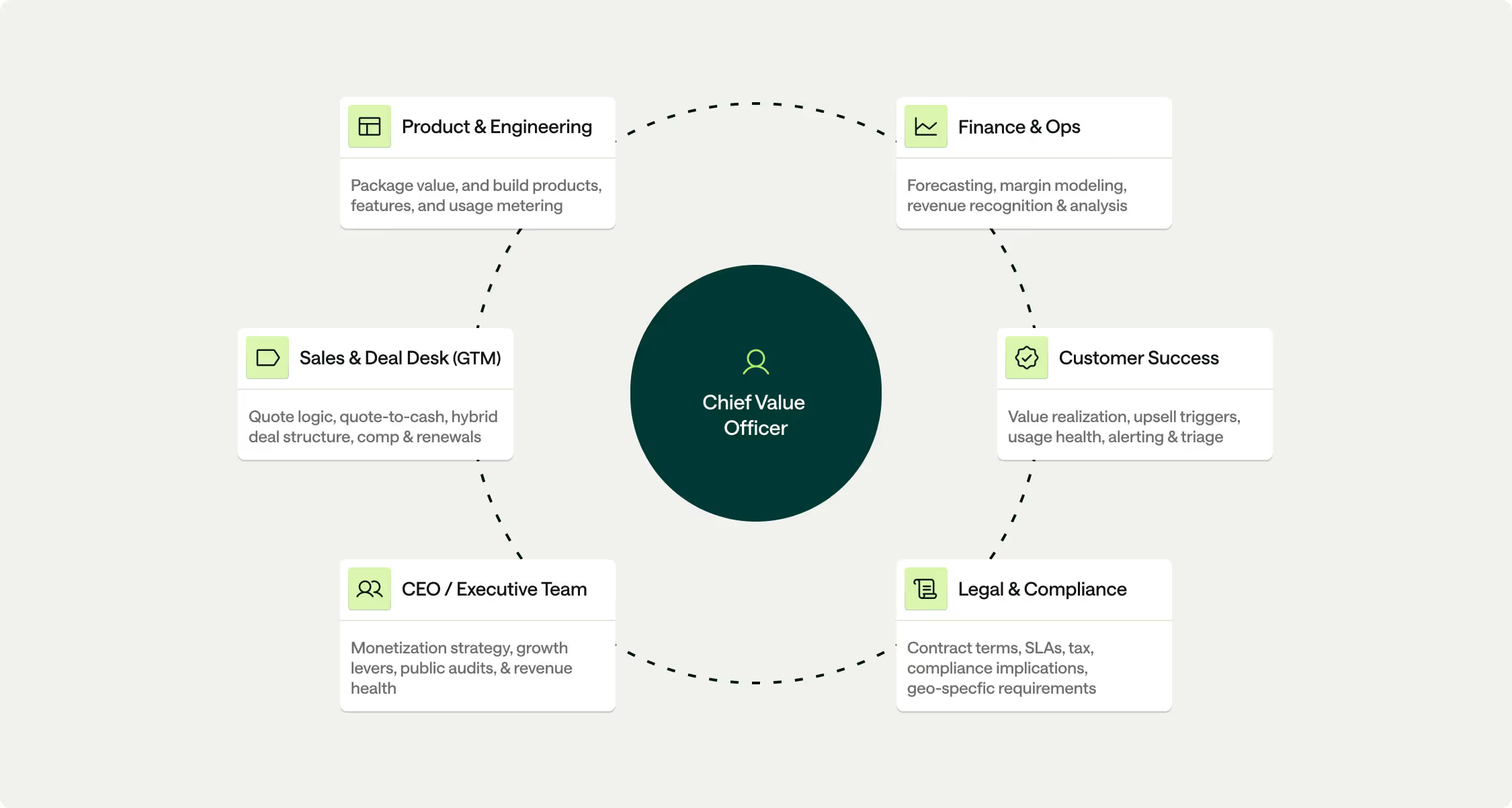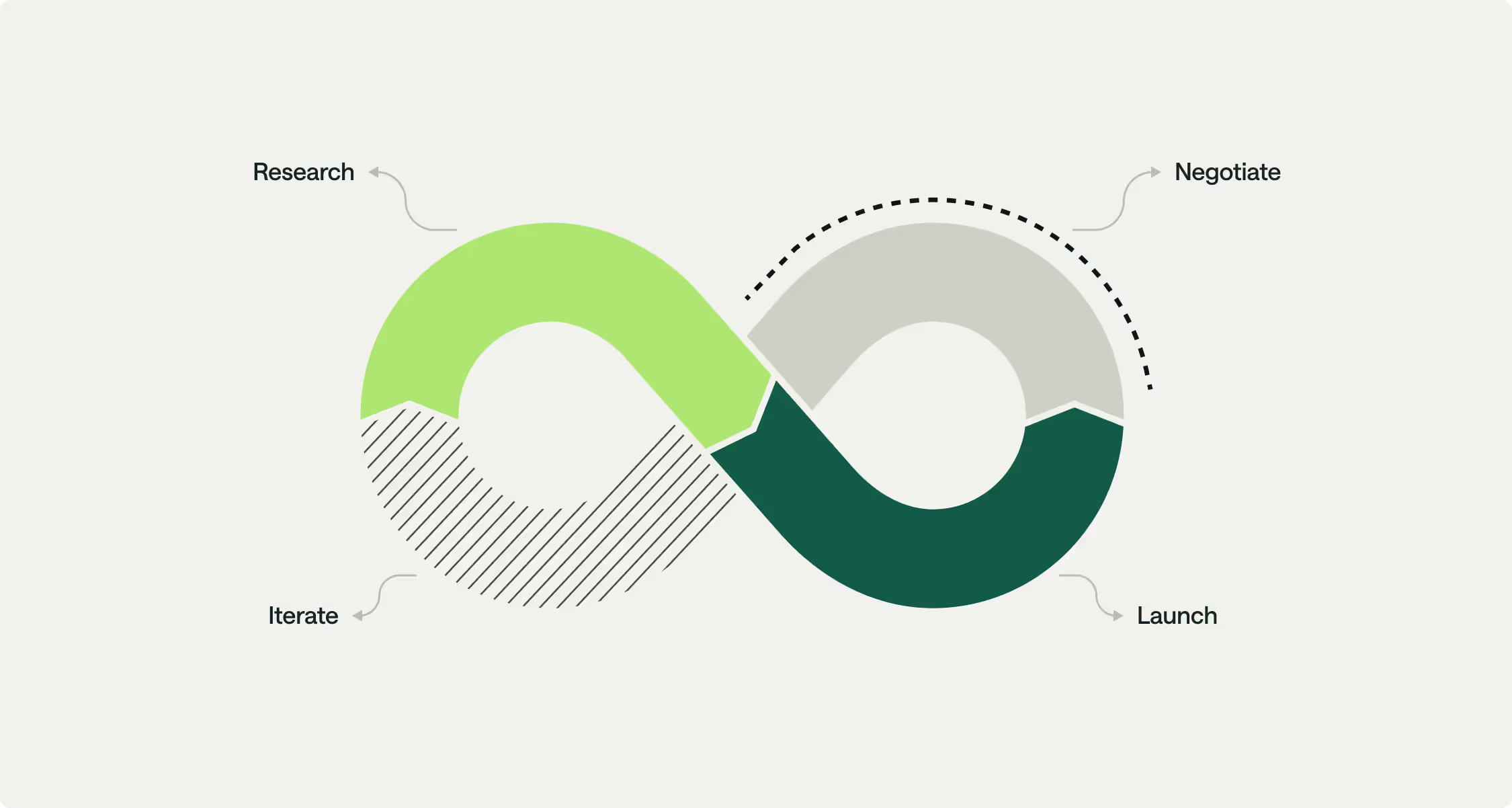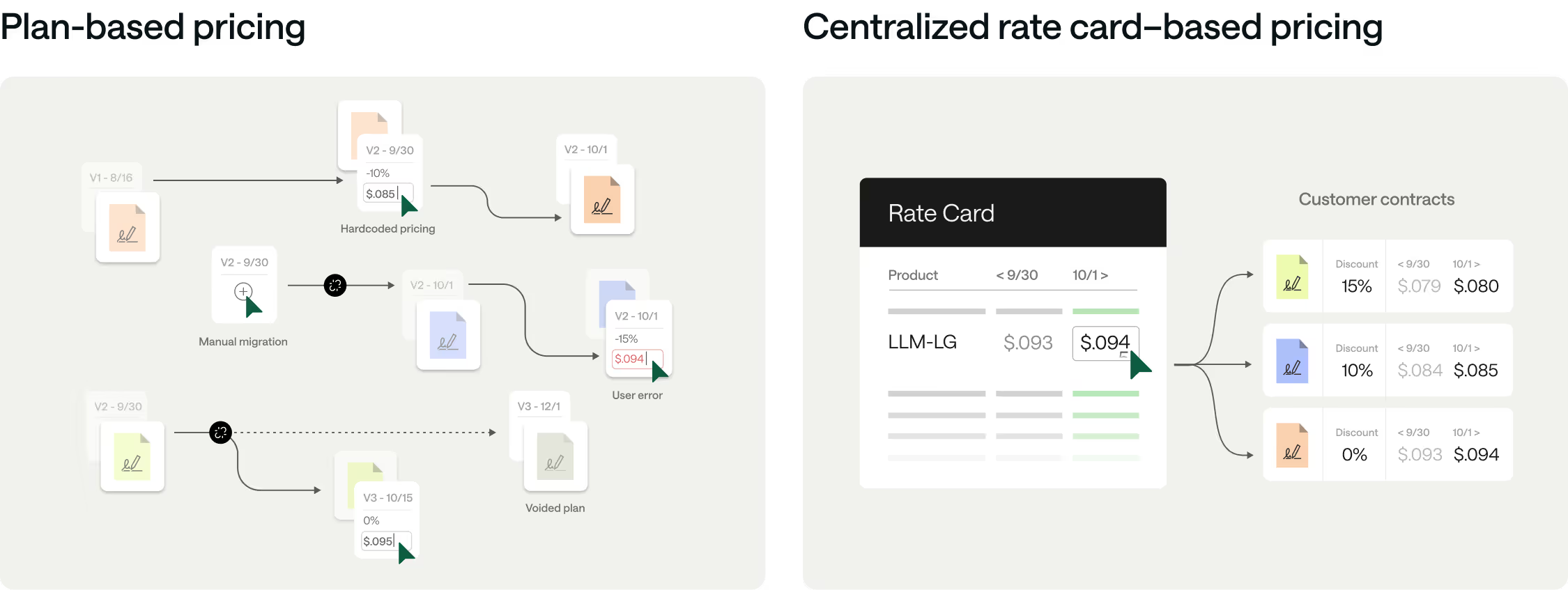The Shift in Value
There are moments in business when the ground shifts beneath your feet—not all at once, but unmistakably. This is one of them.
AI and cloud have accelerated not just how software is built, but how it’s used, deployed, and valued. Products are smarter, delivery is continuous, and impact is more measurable than ever before.
Software has gone from packaged tools to embedded intelligence. It no longer just supports work—it performs it. It automates. It decides. It learns. As market conditions change, products are no longer competing based on the features they ship. They’re now under pressure to compete on the value they deliver. AI accelerates this shift, but it’s part of a broader pattern: value must now be proven, priced, and packaged accordingly.
That evolution has changed more than how software works. It’s changed how value is delivered:
- Continuously instead of occasionally
- Dynamically instead of predictably
- Invisibly instead of visibly
While software has advanced, monetization hasn’t.
Most companies are still pricing like it’s 2015: charging for access, seats, or features, not results. They’re trying to deliver modern value through legacy revenue models.
This disconnect has been building over time, mapped closely to the evolution of value itself.
Monetization has become the bottleneck not because companies lack strategy, but because their systems, orgs, and models weren’t designed for this level of complexity.
The Transformation of Value
In the early days of the Software Era, value was defined by what was included: features, licenses, subscriptions. Pricing was simple, static, and disconnected from outcomes.
As cloud infrastructure matured, the Access Era emerged. With access to dynamic and ephemeral infrastructure and data, cloud required a rethink of traditional on-premises licenses and introduced subscriptions. Subscriptions and basic usage-based models introduced more flexibility but still used access and activity as a proxy for value.
Both the Access and Software Eras were simple primitives: you bought a license or paid for a seat, and the core benefit was giving humans access to information or workflows. But AI breaks that model.
AI is fundamentally reshaping the value of software.
Now, in the Value Era, the way software delivers value has shifted toward completed workflows, automated tasks, and decisions made by systems rather than by people. AI has accelerated this evolution, introducing new kinds of labor that software performs autonomously. This shift has made outcome-based pricing not just possible, but inevitable. It may still be early, but the future of software monetization is clearly tied to what gets done—not just what gets used.
While the concept of value-based pricing resonates with many teams, especially those working with AI or automation, the shift is complex. It requires new ways of thinking about value, new systems for metering, and new language and ways to communicate that value to customers. It’s not yet the norm, but the vision is clear: a future where pricing more closely reflects what gets done, not just what gets accessed or consumed. And increasingly, companies are starting to move in that direction.
Value transformation over time
From software to cloud to AI & beyond

But the shift in how software delivers value has forced companies to rethink how they monetize it. And that’s where things have gotten exponentially more complex.
The Complexity of the Shift
Mapping pricing to value sounds simple. But in practice, the complexity can be overwhelming.
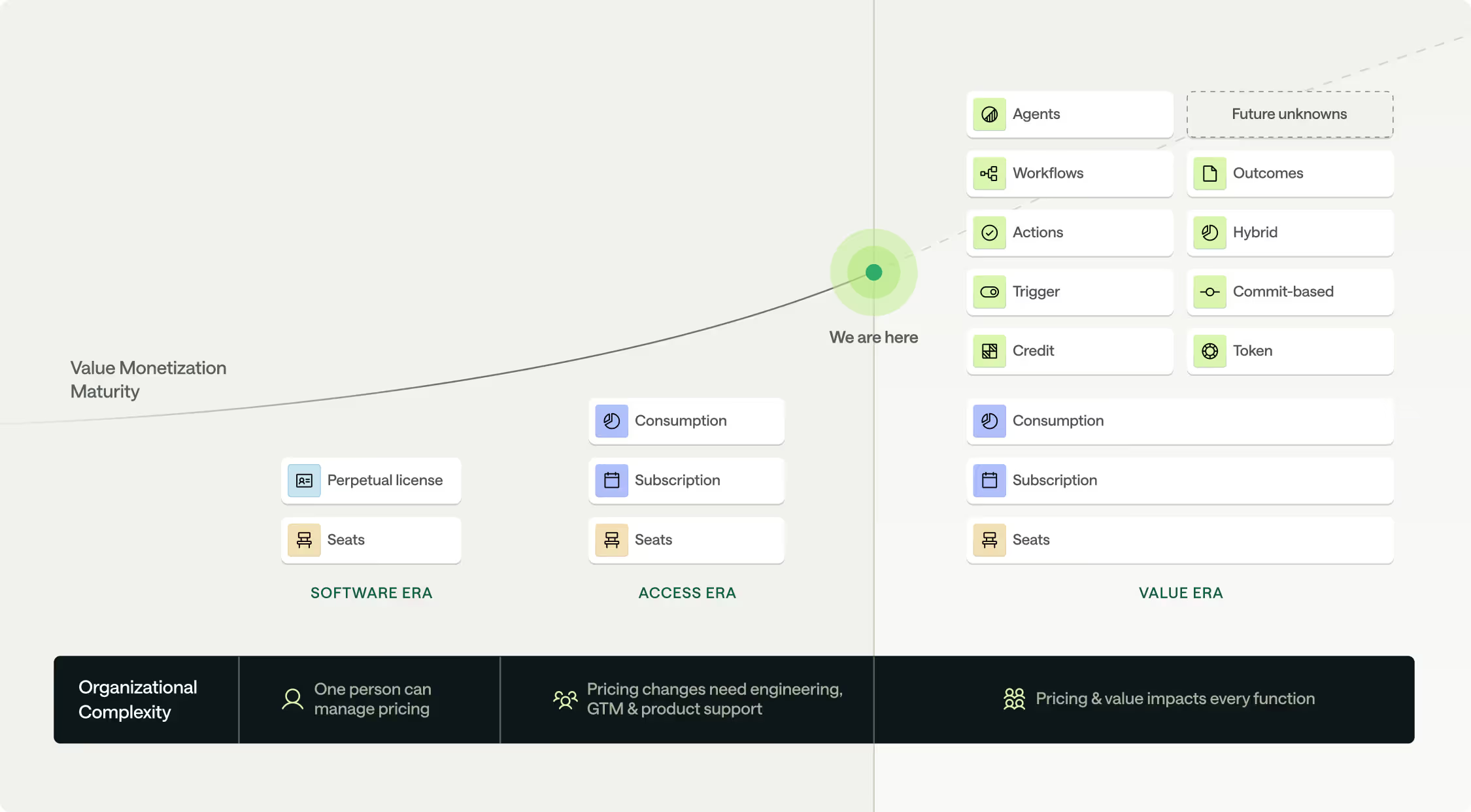
Value Differs Across Customers
One customer might measure value by the number of automated tasks completed or insights generated by AI. Another might care more about speed, scale, or time saved. Whether it’s tokens used, workflows executed, or data processed, value is no longer one-size-fits-all—and your pricing model has to reflect that.
Value Differs Within a Single Account
A data engineer might care about performance. A finance leader might focus on predictability and control. The same product can serve multiple stakeholders with different priorities, and pricing needs to support all of them.
Product Updates Constantly Reshape Perceived Value
Every new feature, model improvement, or UX change can alter how customers use and value your product. In a dynamic product environment, pricing must adapt just as quickly as the product evolves.
AI Accelerates This Dynamism
AI-driven systems optimize, iterate, and act on their own. That means value isn’t delivered in fixed increments; it unfolds continuously, often in ways customers didn’t explicitly initiate. Today’s pricing systems must handle that fluidity in real time.
The Explosion of Pricing Models
Pricing models have rocketed from straightforward, static licenses to dynamic combinations of:
- Usage-based metrics (API calls, tokens, compute hours)
- Agent-based pricing
- Workflow-based pricing
- Outcome-based pricing
- Commit-based deals, true-ups, and overages
- Regional variations and dynamic rate cards
- Segmented plans
- Flat fees, variable components, credits, thresholds, and entitlements
- Self-serve pricing and enterprise contracts
- Freemium tiers and upgrade paths
- Seats, subscriptions, and hybrid models
Monetization isn’t one model anymore. It’s dozens, often running in parallel.
The Monetization Complexity of PLG + SLG
As companies adopt product-led growth (PLG) and pair it with sales-led growth (SLG), monetization becomes exponentially more complex. You’re no longer managing one entry point or pricing motion; you’re stitching together free tiers, usage thresholds, seat-based plans, overages, enterprise commitments, and negotiated custom contracts.
It’s powerful—but chaotic.
Without a unified pricing system, teams end up duplicating logic across systems: one model for self-serve, another for sales quoting, a third for invoicing. Revenue is lost in translation. Product can’t move fast because every pricing change breaks something downstream. Finance spends quarter-end reconciling conflicting truth sources.
The PLG + SLG model unlocks growth, but only if your pricing and billing infrastructure can support its fragmentation—with versioning, orchestration, and observability built in.
Every function is impacted
This isn’t just a pricing problem:
- Sales: What are you promising?
- Marketing: What value are you trying to communicate?
- Product: What outcomes are you shipping?
- Engineering: What are you metering?
- Finance: What are you billing?
Even a small product change can cascade through every function. Sales needs to pitch it differently. Product needs new success metrics. Finance has to change billing logic.
All of that stems from a single shift in how value is delivered.
This fragmentation introduces operational strain, tooling challenges, and organizational confusion.
Why the Shift Is Happening
The reason monetization is under pressure today isn’t just because pricing models are evolving. It’s because the nature of software, and the conditions surrounding it, have fundamentally changed.
What Companies Are Selling Has Changed
AI and automation have transformed software from a tool into a worker. It performs tasks, drives outcomes, and replaces human labor. This shift redefines value, and it demands new ways to meter, measure, and monetize.
Even non-AI software now faces rising expectations: if customers use it, they expect pricing to reflect actual results, not proxies like logins or seats.
Buyers Expect Price-to-Value Alignment
SaaS bloat, tighter budgets, and more sophisticated procurement have pushed buyers to scrutinize contracts.
They want clarity, control, and confidence that pricing reflects real impact. With a market that now prizes efficiency, every budget line is under the microscope, especially as AI raises the threat of disruption from leaner, AI-native competitors. Pricing is now a key part of the value story.
Monetization Has Become Strategic Infrastructure
Category leaders like Snowflake, Salesforce, and Databricks didn’t just innovate on product—they innovated on monetization. They built pricing into the product experience. They made it dynamic, scalable, and aligned with adoption. By pairing generational products with equally innovative monetization engines, they turned monetization into a competitive edge
Today, pricing isn’t a late-stage decision. It’s a strategic design choice baked into the business model from day one.
…And Why It’s Good
Despite the complexity, this shift is a massive opportunity.
The complexity of modern monetization isn’t a problem to eliminate—it’s a capability to harness. The shift from simple pricing models to hybrid, dynamic structures isn’t just more complicated—it’s more powerful. But only if organizations and their customers can operate with three critical properties: predictability, visibility, and control.
For the Business: Better Execution, Faster Growth
These are the conditions required for companies to confidently scale modern pricing models.
- Predictability means finance can forecast revenue and margins, even in usage-based or AI-driven models. That requires real-time data, structured rate logic, and packaging rules that hold up under pressure.
- Visibility means product and GTM teams understand how pricing drives behavior: what’s adopted, where value is delivered, and how to tie that directly to monetization strategy.
- Control means teams can iterate, launching new plans, testing ideas, localizing offers, and fixing issues—without relying on engineers or risking billing errors downstream.
Together, these aren’t just operating benefits. They’re growth levers.
For the Customer: Confidence to Adopt and Expand
The real test of a pricing model is how it feels to customers. Modern buyers want clarity, consistency, and responsiveness in how they’re charged. Without these three pillars, pricing creates friction and stalls expansion:
- Predictability builds trust. Customers need to understand what they’ll pay and why, especially in AI- or usage-driven models where unit costs can vary.
- Visibility enables self-service and decision-making. When customers can see how usage maps to spend, they engage more deeply and expand more confidently.
- Control lets customers scale on their own terms. They can explore pricing options, project future costs, and work within known boundaries without surprises.
When companies deliver these outcomes to customers, monetization becomes an accelerant to product adoption, not a barrier to it.
Value monetization builds trust, drives expansion, and creates defensible revenue streams. Done right, it becomes a core growth system.
When monetization aligns with how value is delivered:
- Customers feel pricing is fair and tied to results, not risk.
- Vendors make more money, serve more segments, and grow faster.
- Finance gains forecasting precision and margin clarity.
- Product gets tighter feedback loops between delivery and revenue.
This shift also elevates monetization from a pricing lever to a strategic enabler:
- It aligns incentives across teams.
- It powers land-and-expand models.
- It makes revenue predictable, efficient, and scalable.
Companies that modernize monetization won’t just charge better. They’ll win faster.
How to Win the Shift
Pricing as a Product
Today, pricing changes constantly to support new segments, revised packaging, product launches, and GTM shifts. It’s no longer something you can define once and forget. To keep up, pricing needs to be managed with the same rigor and structure as any other product surface, which means your pricing is your product.
Treating pricing like a product means giving it ownership, instrumentation, and an operational lifecycle. Just like any customer-facing surface, pricing decisions impact adoption, retention, expansion, and revenue. They need to be built, tested, and improved accordingly.
What it means to productize pricing:
- Dedicated ownership: Someone needs to own the roadmap, backlog, and outcomes of pricing—not just approve it once a year.
- Real-world telemetry: Just like features, pricing needs instrumentation: how customers interact with it, where confusion arises, and where dropoff happens.
- Structured change process: Pricing updates should follow a lifecycle: hypothesis, packaging, rollout, measurement, and iteration. They shouldn’t be treated as last-minute patches.
- Cross-functional input: Product, finance, sales, and marketing all shape pricing. Treating it as a product gives them a shared framework to collaborate.
This mindset forces a more rigorous, accountable approach. It reduces pricing risk. It makes experimentation possible. And it unlocks speed when companies need to shift strategy or respond to market pressure.
Teams that treat pricing like a product grow faster because they can align value, execution, and monetization in real time.
People, Process, and Tools
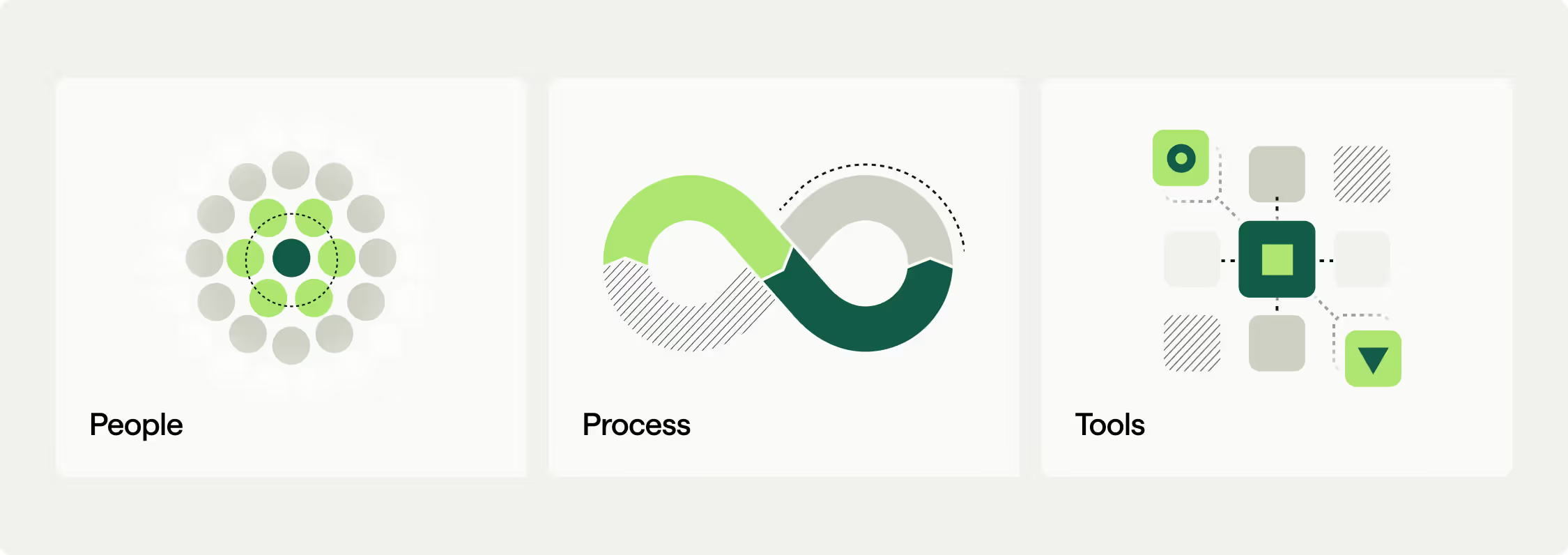
Getting pricing right in this new era isn’t just about changing what you charge for; it’s about how your company runs.
As pricing moves from static models to dynamic, value-based systems, the real challenge isn’t strategy, it’s execution. You need someone who owns the system. Not just pricing logic, but how it’s defined, packaged, shipped, and evolved across teams.
That role increasingly falls to a new kind of leader, someone who sits across product, finance, engineering, and GTM, and makes sure monetization doesn’t fall through the cracks. Whether it’s a Chief Value Officer or a Head of Monetization, this person drives the motion: connecting how value is delivered to how revenue is captured.
But ownership alone isn’t enough. To actually win the shift, you need the right structure behind it, people with clear responsibilities, processes that support iteration, and tools that can handle the complexity.
That’s what the next section covers: how to make value-based monetization operational and repeatable.
The path forward isn’t just about believing in the shift—it’s about executing on it.
People
The hardest part of value monetization is ownership. The more flexible and powerful your pricing becomes, the more cross-functional it gets. And that makes it hard to answer a deceptively simple question: Who’s responsible for making pricing work?
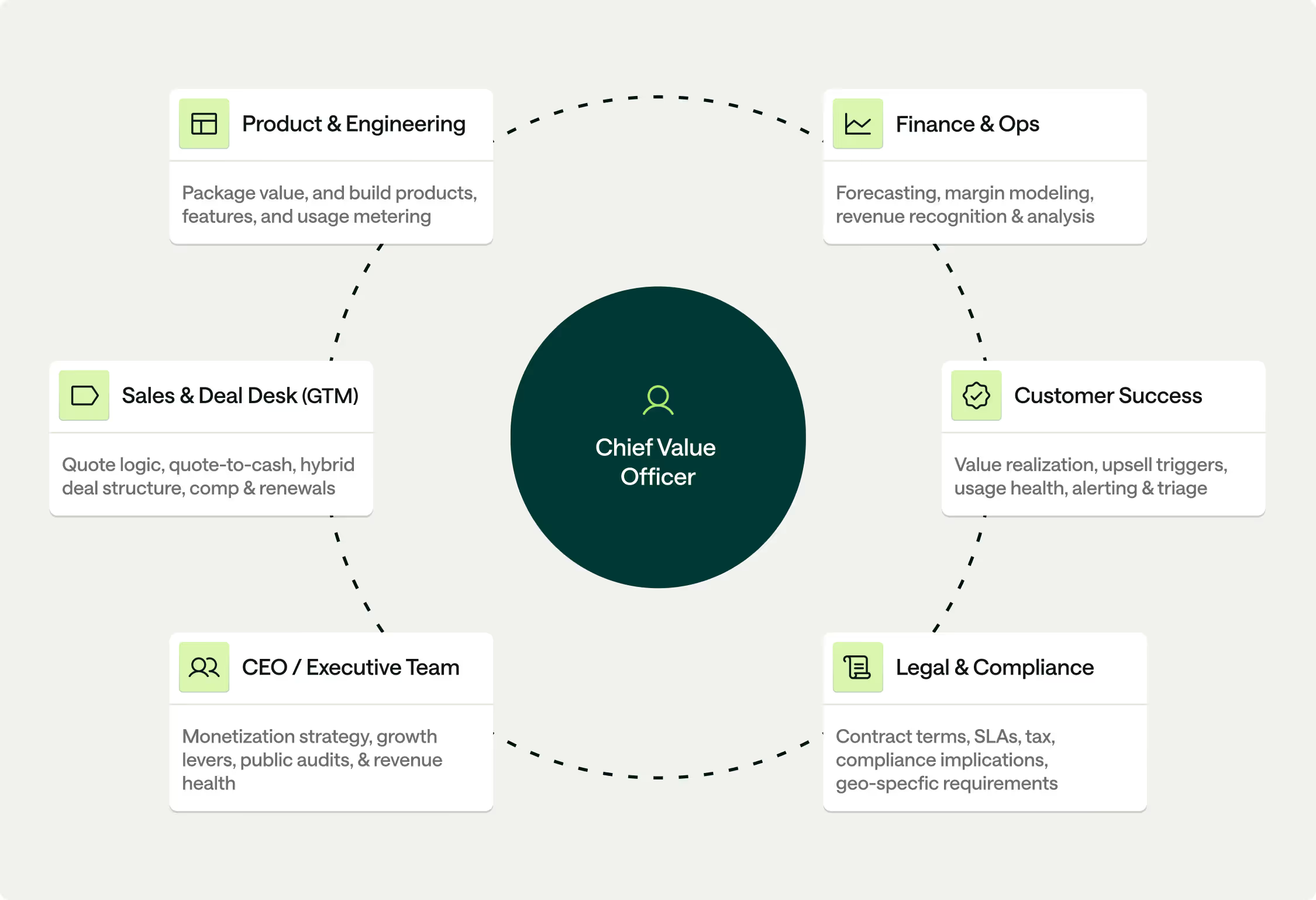
Most companies never answer it cleanly. Pricing lives in product, until finance needs a forecast. It lives in GTM, until engineering needs to meter usage. It lives in RevOps, until someone has to explain it to a customer.
The reality often is: everyone touches pricing, but no one owns the system.
A functioning operating model depends on clear roles, on people who are empowered to define pricing strategy, translate it into execution, and drive iteration across the business.
What this looks like in practice:
- Product defines how value is delivered and its unit of measure (e.g., tokens, agents, workflows, outcomes).
- Engineering enables instrumentation, metering, and rate cards so activity ties directly to billing.
- Finance governs pricing and translates it into forecasts, margin models, and revenue plans.
- GTM communicates pricing clearly, drives adoption, and identifies opportunities for iteration.
- RevOps or Monetization Ops becomes the connective tissue, owning the pricing system, rollout processes, and experimentation infrastructure.
In early-stage orgs, this might all start with one or two people. That’s fine. What matters is not how many people are involved, but whether the key roles are defined and connected.
Appoint Ownership and Align Teams
Modernizing monetization requires clear ownership across value definition, packaging, delivery, and measurement.
That’s why companies are creating roles like Head of Monetization, VP of Value, or embedding the function inside product or RevOps teams. Whatever the title, the mandate is the same: own the monetization system. We call them the Chief Value Officer, or CVO.
They partner with product to define measurable value units. They align with finance to forecast using real-world usage. They equip GTM to sell outcomes, not features. And most importantly, they drive iteration—not once a year, but continuously.
In early-stage companies, this might be a single operator. At scale, it becomes a cross-functional team. The structure isn’t critical. Ownership is.
Process
Pricing is an ongoing discipline, not a one-time decision. For companies delivering continuous value, monetization must operate the same way: as a repeatable, evolving loop that never stops running. At the same rapid pace they iterate on product, companies need to iterate on how value is delivered, understood, and monetized.
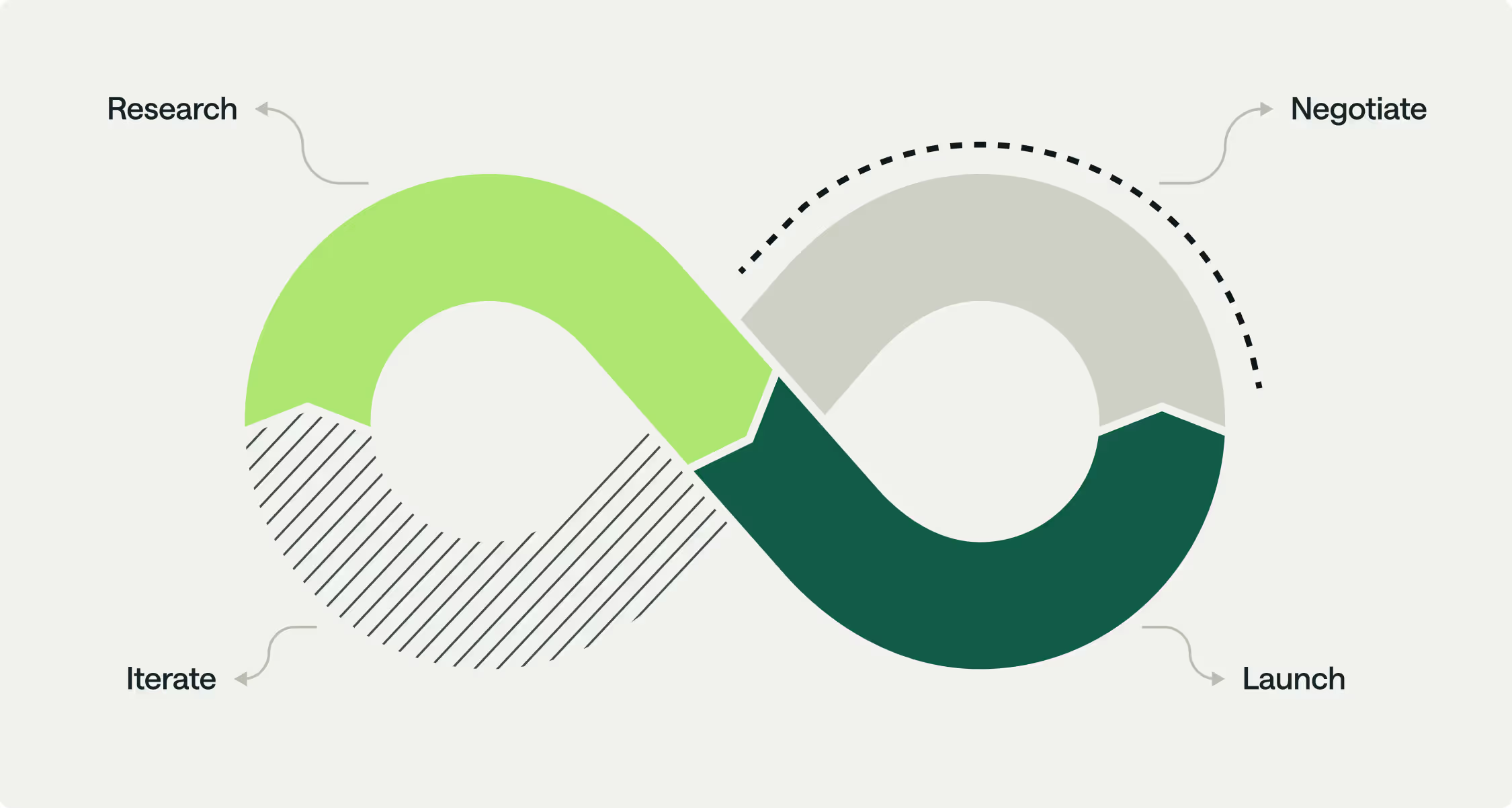
The most effective teams treat pricing like a product motion. It moves through four stages, over and over:
- Research
Start with clarity. Understand how your product creates value, what customers care about, and how competitors position and price it. Identify the pricing models that best align with what your product actually delivers. - Iterate
Pricing isn’t static. Experiment with billable metrics, thresholds, segmentation, and packaging. Pressure-test each change across GTM, product, and finance to ensure it works technically, commercially, and operationally. - Negotiate
Internally, align on how value is shared. Every pricing decision reflects tradeoffs between monetization and adoption, between product simplicity and flexibility, and between short-term growth and long-term margins. - Launch
Ship. Roll out new pricing with the same rigor you’d apply to any product release. Instrument usage. Enable the field. Track performance. Capture learnings—and feed them straight back into the loop.
Modern monetization demands a continuous operating rhythm. When the loop runs well, it becomes a source of durable advantage.
Tools
You can have the right strategy, people, and processes, but without the right tools, monetization doesn’t scale. Most legacy systems weren’t built for usage-based or outcome-based pricing, especially not for AI. They weren’t built to support experimentation, rapid product changes, or pricing flexibility across GTM motions.
Metronome is.
What’s required is a platform that:
- Supports flexible, modular pricing
- Meters usage and outcomes in real time
- Connects product data to billing, forecasting, and quoting
- Enables rapid iteration without risk to revenue or customer trust
It’s the infrastructure layer for value monetization, built to handle real-time usage, pricing complexity, and billing scale with precision and reliability. It doesn’t just support the operating model. It makes it executable.
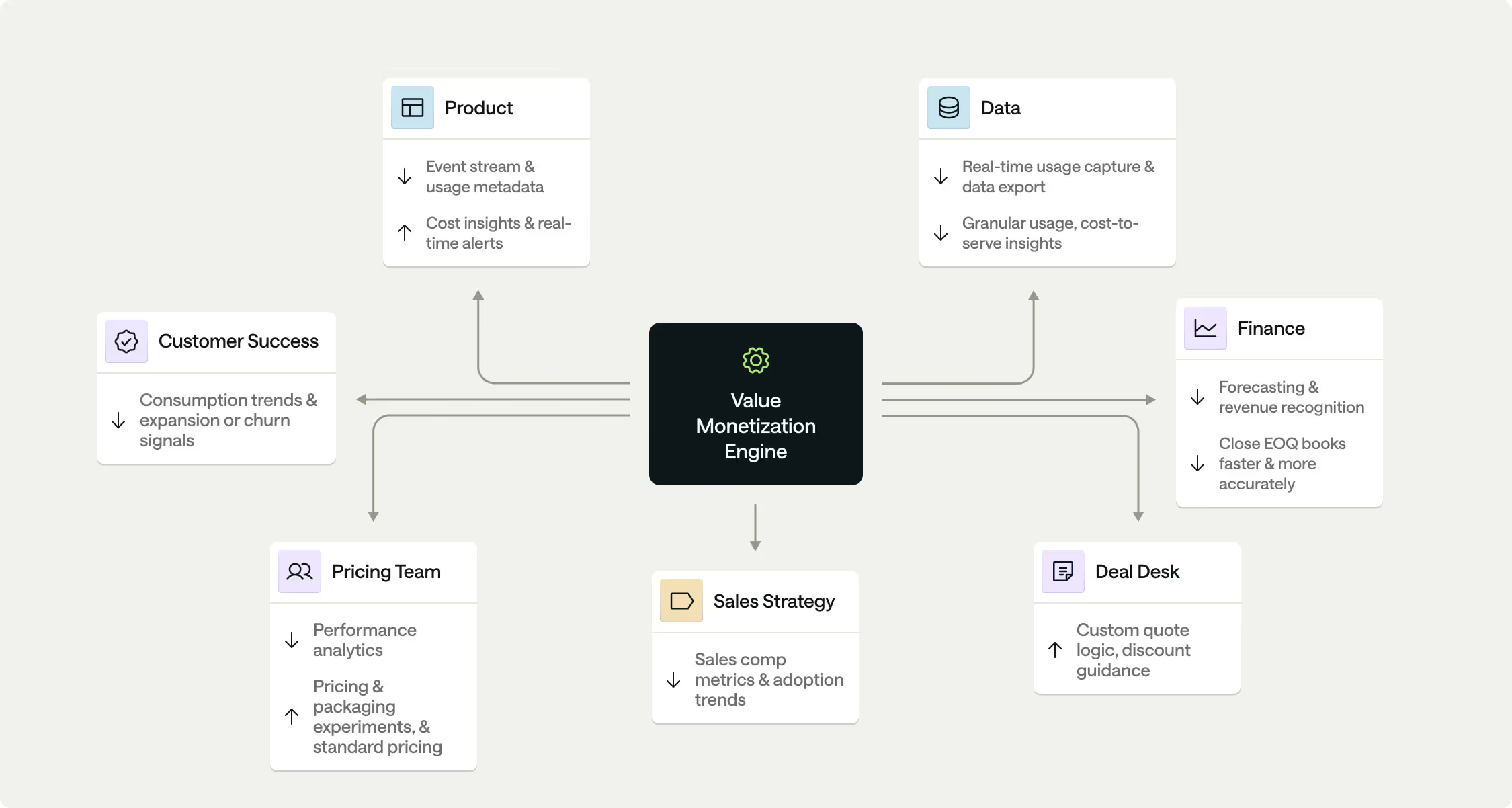
How Metronome operationalizes the model:
- Self-serve pricing and billing for product teams
Metronome decouples pricing logic from engineering. Product teams can define pricing units (e.g., API calls, agent runs, workflows) and attach them to SKUs in a central UI or via API. New pricing models can be configured, tested, and deployed without touching the billing pipeline. - Systematize pricing logic with a dynamic, global pricing catalog
Pricing rules, including rate tiers, thresholds, minimums, overages, and discount logic, are managed centrally and versioned. Teams can assign different pricing logic by customer type, region, or product line. Metronome ensures the correct logic is applied at runtime. - Enable safe pricing experimentation
Pricing changes are version-controlled. You can roll out new pricing to specific cohorts, grandfather existing customers, and use Metronome’s built-in rollback capabilities to revert changes if needed. All experimentation is observable and auditable. - Connect value measurement directly to billing
Metronome ingests usage events like API calls, compute hours, token counts, and completed jobs in real time from your product and transforms them into billable line items. You define what counts as value; Metronome turns it into revenue. - Provide visibility and governance
Every usage event, pricing configuration, and invoice is traceable. Finance can drill into margin at the SKU or customer level. Support teams can answer billing questions with full, event-level detail. Pricing history is fully auditable—no buried overrides or mystery charges. - Support cross-functional collaboration
Metronome acts as the shared source of truth. Product, finance, ops, and GTM all work from the same platform. Entitlements, usage data, pricing logic, and billing records are unified, so teams don’t have to reconcile five systems to answer one question.
Organizations need a monetization platform that’s built for flexibility, accuracy, and scale. Whether you’re launching your first usage-based SKU or managing thousands of customers across multiple pricing models, Metronome provides the infrastructure to make it work.
To move forward, companies don’t just need a new pricing model. They need a new operating model—one built for how value is delivered, captured, and monetized in today’s economy.
The Monetization Operating Model
The operating model for value monetization is the system of capabilities that enables a company to deliver and capture value through pricing, packaging, and billing. It lets teams evolve pricing as fast as they ship and scale revenue without adding friction or risk.
Done right, this model becomes the foundation for experimentation, flexibility, and clarity across every function that touches revenue.
What the Monetization Operating Model Must Enable
A complete operating model includes the following capabilities:
- Self-serve pricing and billing for product teams
- Safe, flexible pricing experimentation
- Systematized pricing logic with rate cards
- Direct connection between value measurement and billing
- Clear visualization and communication of product value
- Smooth transition to results-based and hybrid models
- Shared visibility into pricing structure and performance
- Granular version control and pricing governance
- Unified data platform as a source of truth
- Cross-functional alignment across product, finance, GTM, and engineering
- Adapting sales for the Value Era
The following sections dive deeper into each of these capabilities and how they come together to form a modern monetization system.
1. Self-Serve Pricing and Billing for Product Teams
In most organizations, adding or changing pricing requires a gauntlet of tickets, approvals, and backend rewrites.
That doesn’t scale. The operating model treats pricing as a product-layer capability, not a backend constraint.
This means product and platform teams must be able to plug new features or SKUs into a flexible pricing system without involving finance or engineering in every change.
Key capabilities to enable this:
- Instant propagation of pricing updates across the customer base through centralized rate cards and API-driven pricing management.
- Configurable pricing logic for any SKU: usage, agent, seat, token, or outcome
- Centralized pricing system that enforces entitlements and billing without custom code
- Guardrails to prevent inconsistencies, errors, or unapproved pricing launches
- Role-based permissions and approval flows for sensitive pricing changes
- Integration with product development workflows (e.g., pricing as part of the feature spec)
What good looks like:
- New product pricing can go live in minutes, with confidence that billing, entitlements, and metrics will just work.
- A PM shipping a new feature can select a pricing model, define usage units, and push to staging without a billing engineer.
- Pricing logic is defined in an abstraction layer—not hardcoded in multiple systems.
- Finance can review and approve new pricing without being a blocker to velocity.
2. Safe, Flexible Pricing Experimentation
Modern pricing is a product surface. It should be dynamic, testable, and always evolving. But in most companies, even small changes require heavy coordination, fragile handoffs, and risky downstream impacts. An effective operating model bakes experimentation into the system from day one.
Pricing experimentation workflow
A step-by-step flow for safely designing, testing and launching new pricing models

Today’s monetization structures are layered, dynamic, and increasingly abstract. Pricing is no longer just a list of SKUs—it’s a system of entitlements, thresholds, and logic that needs to flex across product lines, buyer types, and delivery models.
Each structure adds operational overhead, from how value is measured and billed to how finance forecasts revenue. And most companies don’t rely on just one model. They combine many, often without a common foundation. Most teams are doing their best to adapt, but the current tooling wasn’t built for this level of complexity.
Key capabilities to enable this:
- Versioned pricing catalogs for A/B and multivariate pricing tests
- Feature flags and segmentation for progressive pricing rollouts
- Versioned pricing plans that can be safely grandfathered or reversed
- Observability into pricing performance by cohort, SKU, and metric
- Guardrails to prevent incomplete or conflicting logic across systems
What good looks like:
- Pricing tests can be scoped to a customer segment or feature flag without billing rework.
- GTM and product teams can test new monetization strategies, usage thresholds, bundles, and outcome-based pilots live, without waiting on engineering sprints.
- Rollbacks are safe and fast. Grandfathering logic ensures existing customers aren’t impacted unexpectedly.
- Pricing iterations happen continuously, not once per year, and are backed by performance data.
3. Systematized Pricing Logic with Rate Cards
Most pricing models start as one-offs: a few SKUs here, some metering logic there. But as complexity grows across plans, personas, geos, and use cases, ad hoc pricing becomes a liability. Teams lose visibility. Customers get inconsistent experiences. Finance can’t forecast. Sales go off-road.
.avif)
A structured rate card system brings order. It defines how pricing is applied across products, usage types, and customer segments and ensures every team is working from the same logic.
Key capabilities to enable this:
- A central catalog of pricing dimensions: SKUs, units, thresholds, tiers, overages
- Support for multiple models: flat-rate, usage-based, hybrid, outcome-based
- Configurable rate cards by customer type, plan, region, or delivery model
- Mappings between features, entitlements, and pricing logic
- Support for quoting, billing, and revenue recognition against the same source of truth
Key capabilities to enable this:
- Product managers define pricing rules from a menu, not from scratch.
- Sales and finance work from a standardized structure when building quotes or forecasting.
- Pricing can be adapted per market or persona, without duplicating logic or breaking downstream systems.
- Rate cards are version-controlled and auditable, making it easy to roll out changes or trace historical activities.
4. Direct Connection Between Value Measurement and Billing
You can’t price what you can’t measure. And you can’t bill what you can’t trust. As companies move toward usage- and outcome-based models, the gap between product telemetry and billing systems becomes one of the biggest sources of friction and revenue leakage.
The operating model must close that gap, ensuring that what the customer uses, receives, or achieves is directly tied to what they’re charged for.
Key capabilities to enable this:
- Usage and outcome signal instrumentation at the product level
- Standardized event schemas and metering pipelines
- Real-time syncing between product usage and billing/entitlement systems
- Ability to distinguish between technical activity and monetizable value
- Margin-aware tracking of high-cost features or services
What good looks like:
- Product events like API calls, agent invocations, or workflows completed are metered in real time.
- Those usage signals are mapped to SKUs, pricing logic, and customer entitlements automatically.
- Finance doesn’t have to guess at usage; they see the same numbers product does.
- Edge cases and high-volume outliers are flagged, so billing errors or COGS spikes don’t go unnoticed.
5. Clear Visualization and Communication of Product Value
Even when pricing is technically correct, it can still feel wrong to the buyer. That’s because most customers don’t just want to understand what they’re paying. They want to understand what they’re getting. And when value is invisible, unpredictable, or hard to map to the bill, trust erodes.
The operating model must ensure value is both delivered and visible—to customers and to internal teams.
Key capabilities to enable this:
- Customer-facing dashboards that show usage and outcomes tied to pricing
- Internal reporting that links feature usage to account health and revenue growth
- Proactive alerts for underused or overperforming features
- Executive-level summaries that explain how pricing maps to business value
- Shared language across product, GTM, and finance for value communication
What good looks like:
- Customers see a clear connection between their activity and their bill, tokens used, jobs run, and outcomes achieved.
- Success and renewal teams use usage and value metrics to drive retention, not just sentiment.
- Pricing objections drop because customers understand the ROI behind the charge.
- Internal teams can tell a coherent story: what the product does, what the customer gains, and why the pricing makes sense.
6. Smooth Transition to Results-Based and Hybrid Models
As monetization evolves, very few companies move cleanly from one model to another. More often, they operate in a hybrid state, charging for seats in one product, usage in another, and results in a third. That complexity creates operational drag unless it’s intentionally supported by the model.
A modern operating model enables a smooth transition from old to new, not just support of new pricing types.
Key capabilities to enable this:
- Support for multiple pricing models running in parallel (e.g., seats + usage + outcomes)
- Account- and SKU-level pricing flexibility
- Migration tooling: plan changes, dual invoicing, and grandfathering
- Results-based measurement frameworks (e.g., milestones, success metrics, shared outcomes)
- Contract flexibility for hybrid deal structures
What good looks like:
- A company can introduce an outcome-based pricing layer on top of usage pricing without breaking billing, support, or RevRec.
- Some customers are still on seat-based pricing, others are in pilots for usage or value-based models, and the business can support both.
- Finance can forecast across models. Sales can quote confidently. Product can ship without waiting on pricing to catch up.
- Shifts happen gradually, not all at once, and the infrastructure supports every stage.
7. Shared Visibility into Pricing Structure and Performance
Pricing isn’t just a product decision or a finance function. It impacts how GTM teams position the product, how engineering instruments it, and how leadership models the business. When each team works from a different view of pricing, with spreadsheets here, hardcoded logic there, execution breaks down.
The operating model must provide shared visibility into how pricing works and how it performs.
Key capabilities to enable this:
- A centralized source of truth for pricing logic, SKUs, and entitlements
- Live reporting on revenue, usage, and margin by product, customer, and pricing plan
- Access controls to ensure teams see the data that’s relevant to their role
- Visual tools that clarify how pricing is structured and performing across segments
- Tight integration between pricing systems and internal dashboards or planning tools
What good looks like:
- Finance, product, and GTM teams all reference the same pricing structure, no local spreadsheets or conflicting data.
- Sales and customer success can explain how a customer’s pricing works, without needing engineering to interpret it for them.
- Finance can model revenue accurately because usage is clearly mapped to billing.
8. Granular Version Control and Pricing Governance
Pricing decisions compound. What starts as a quick tweak or one-off exception becomes untraceable tech debt if not managed properly. Without version control, it’s impossible to track changes or audit outcomes, or to understand what any given customer is actually paying for and why.
A scalable operating model treats pricing like product: versioned, governed, and testable.
Key capabilities to enable this:
- Version-controlled pricing plans with change history
- Clear approval workflows for pricing edits, launches, and overrides
- Granular access control for sensitive pricing operations
- Rollback support for fast reversions or hotfixes
- Audit trails for every change: who did what, when, and why
What good looks like:
- Pricing changes are made through a controlled process, not passed around in Slack or buried in spreadsheets.
- Every change is logged and attributable. No more mystery discounts or rogue edits.
- Product and finance teams can see when pricing model changes impacted revenue or retention.
- Compliance and audit needs are met out of the box, not as a retrofitted process.
9. Unified Data Platform as a Source of Truth

The operating model depends on a single, reliable source of truth across pricing, usage, entitlements, and billing, so every function can operate with confidence.
Key capabilities to enable this:
- A centralized data platform that captures usage, pricing, and billing events
- Standardized data models and schemas across all monetization functions
- Real-time ingestion and reconciliation across systems (product, billing, CRM, ERP)
- API-accessible data for reporting, experimentation, and forecasting
- Governance and controls to ensure consistency, compliance, and reliability
What good looks like:
- Every team, from engineering to finance, uses the same core dataset to make decisions.
- Usage data, pricing logic, and billing events are reconciled automatically.
- Forecasting, margin tracking, and customer reporting are powered by live, reliable data, not stitched together manually.
- There’s no debate over what’s “true”—the platform defines it.
10. Cross-Functional Alignment Across Product, Finance, GTM, and Engineering
Monetization isn’t a department. It’s a collaboration. But most organizations are structured in ways that fragment pricing across teams: product owns packaging, finance owns billing, sales owns negotiation, and engineering owns implementation. Without alignment, even great pricing strategies fall apart in execution.
The operating model must define how these teams work together, with shared context, data, and accountability.
Key capabilities to enable this:
- Clearly defined ownership for pricing decisions, execution, and iteration
- Cross-functional workflows that bring teams together at the right moments (e.g., new feature pricing, plan changes, migrations)
- Common frameworks and language for value, pricing, and entitlements
- Shared systems and tools to prevent handoff gaps and miscommunication
- Executive visibility into monetization performance across functions
What good looks like:
- Product, finance, and GTM are aligned on the “why” behind pricing decisions, not just the mechanics.
- Teams understand how their piece connects to the full monetization lifecycle.
- Revenue moves quickly and smoothly with defined ownership, aligned incentives, and cross-team clarity.
- Pricing becomes a point of leverage across the company, not a source of tension.
11. Adapting Sales for the Value Era
Nowhere is this shift more disruptive than in sales. Most reps were trained to sell static pricing, a fixed offer, clear ACV, and predictable terms. But in a usage- or value-based world, deals often start smaller and grow over time.
This changes how reps engage customers, how compensation is structured, how pipeline is forecasted, and how closely sales partners with product and success. Teams that thrive in the Value Era don’t just update pricing; they update how they sell it.
The Infrastructure for Value Monetization
Now that we’ve defined the Monetization Operating Model, this section breaks down the infrastructure that brings it to life. It walks through the workflows that turn value into revenue—from how you define and measure it to how you price, bill, forecast, and evolve.

Each of these stages can be optimized independently, but the real advantage comes when they run on a unified infrastructure built for scale, accuracy, and cross-functional alignment.
Define Value
Value monetization starts by identifying what you’re actually monetizing. That unit, whether usage, access, or outcomes, becomes the anchor for how you structure pricing, build systems, and communicate value to customers. It’s the foundation for every workflow downstream.
- Select the value metrics (e.g., API calls, user seats, workflows completed).
- Align to how customers experience value and success.
- Standardize internal and external definitions.
- Set up inputs for measurement, segmentation, and forecasting.
Instrument Usage
Once value is defined, it must be measured. Instrumentation connects the product to the monetization system, capturing usage in real time and making it reliable, finance-grade, and actionable. It ensures every event, entitlement, or threshold is recorded and available for billing, reporting, and customer visibility.
- Capture relevant usage events and metrics (volume, access, consumption).
- Tag usage to customers, contracts, and pricing models.
- Ensure real-time freshness, accuracy, and durability.
- Power both internal workflows (billing, finance, forecasting) and external ones (dashboards, statements).
Price & Package
This is where monetization logic is applied. Packaging translates measured usage into real-world pricing models, from simple tiers to complex hybrids. Modular, configurable pricing logic allows teams to move fast, adapt, and serve different customer needs, without rebuilding core infrastructure.
- Build pricing models via configuration (not code).
- Support usage-based, tiered, hybrid, or outcome-linked approaches.
- Version rate cards for different products, customers, or regions.
- Apply discounts, bundles, or dynamic thresholds as needed.
- Create reusable pricing primitives that scale with product growth.
Billing & FinOps
Visibility is essential. This stage ties monetization data to business planning, helping teams understand revenue drivers, customer behavior, and future trends. Forecasting and reporting shouldn’t be limited to finance. They should be available across product, GTM, and leadership teams.
- Forecast revenue using real usage and pricing models.
- Track monetization performance by product, segment, or region.
- Analyze margin, discounting, and customer behavior trends.
- Share insights across product, sales, customer success, and finance.
- Inform pricing strategy and roadmap prioritization.
Iterate (Feedback Loop)
Pricing isn’t a set-and-forget decision. This final stage makes pricing dynamic, empowering teams to safely test, learn, and deploy new models without impacting customer experience or risking revenue. It closes the loop from experimentation to insight to scale.
- Simulate pricing changes on historical data.
- Launch A/B tests or segmented rollouts.
- Track performance in real time, and measure uplift or cannibalization.
- Enable safe rollbacks or model refinements.
- Feed learnings back into pricing and product strategy.
Summary
Modern monetization demands more than flexible pricing—it requires a system. The shift from seats and access to usage and outcomes has exposed a gap in how most companies define, deliver, and charge for value. To close that gap, you need an operating model: a clear framework that aligns people, process, and tooling around a shared monetization strategy.
This whitepaper outlined what that model looks like, how to operationalize it, and the infrastructure required to make it work. From pricing logic to billing execution, Metronome provides the platform to turn strategy into scale.
What comes next is the opportunity to turn monetization into a competitive edge. One that connects product, finance, and GTM in real time. One that lets you define value, deliver it, and charge for it, without slowing down.
Metronome was built for the Value Era. If you’re building for it, too, we’d love to build with you.


